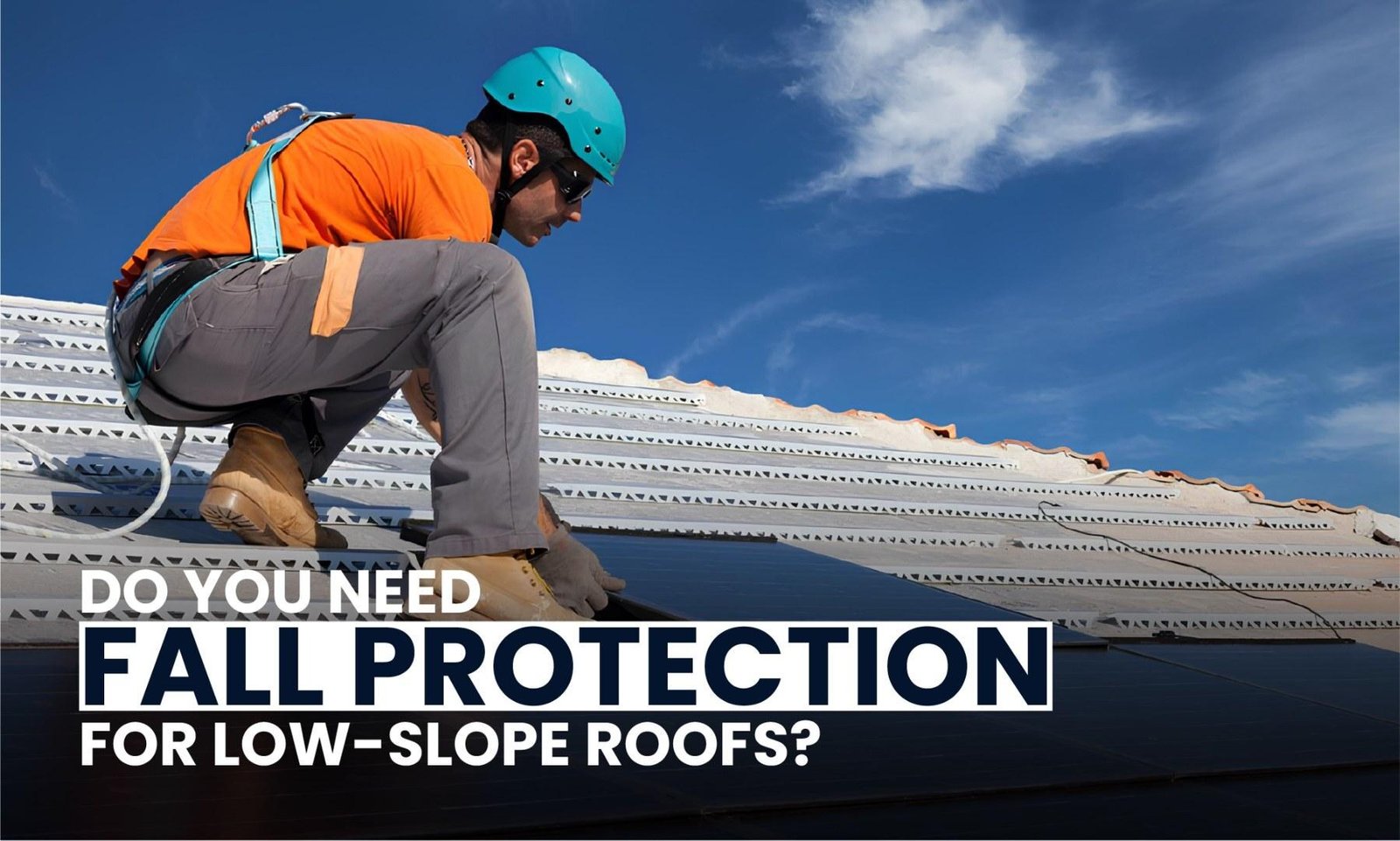-
Web sayfası bildirimcisi
- EXPLORE
-
Blogs
Do You Need Fall Protection for Low-Slope Roofs? Here’s What the Law Says

What is a Low-Slope Roof?
According to the Occupational Safety and Health Administration (OSHA), a low-slope roof is defined as a roof with a slope less than or equal to 4 inches of vertical rise for every 12 inches of horizontal run (4:12 pitch).
While they appear less hazardous than steep-slope roofs, low-slope roofs pose unique risks such as:
-
False sense of security
-
Slipping on gravel, water, or ice
-
Tripping over equipment or materials
-
Unprotected edges
These risks increase significantly without proper fall protection systems in place.
OSHA Regulations on Fall Protection for Low-Slope Roofs
The primary regulation governing fall protection is OSHA Standard 29 CFR 1926.501 (Duty to Have Fall Protection). Here’s what it says regarding low-slope roofs:
General Rule:
If employees are working 6 feet or more above a lower level, fall protection must be provided, regardless of the roof’s slope.
Acceptable Fall Protection Systems for Low-Slope Roofs
OSHA allows employers to choose from several approved systems:
-
Guardrail Systems
Installed around the perimeter of the roof. Must include a top rail (42 inches ±3), mid-rail, and toe boards if materials are present. -
Personal Fall Arrest Systems (PFAS)
Includes a full-body harness, anchorage, and a lanyard or lifeline that limits free fall to 6 feet or less. -
Safety Net Systems
Positioned below the roof edge to catch a falling worker. Not commonly used due to installation difficulty. -
Warning Line System + Safety Monitor
OSHA permits a combination of warning lines and a safety monitor only for roofing work on low-slope roofs 50 feet wide or less.
Special Exceptions and Notes
There are some exceptions and clarifications depending on the width of the roof and the nature of the work:
1. Roof Width ≤ 50 feet
If the roof is 50 feet or less in width, a safety monitoring system alone may be used without warning lines.
OSHA Letter of Interpretation (2000): For roofing work on low-slope roofs 50 feet or narrower, a safety monitor system is considered sufficient fall protection.
2. Temporary Work or Inspection
For infrequent and temporary work (like a quick inspection or minor repair), OSHA has acknowledged that full fall protection may not be required — as long as exposure time is short and the hazard is minimal.
However, this is a gray area, and employers are expected to perform a hazard assessment and document why full fall protection was not used.
Common Misconceptions
“Flat Roofs Don’t Need Fall Protection”
Even flat roofs with no visible slope are included in OSHA’s regulations. If you’re 6 feet or more above the ground and exposed to an edge, you need protection.
“A Parapet Wall Is Enough”
Not always. OSHA considers a parapet a form of fall protection only if it is at least 39 inches high. Anything lower requires additional safety measures.
Why This Matters: Risk vs. Compliance
Beyond legal compliance, proper fall protection is a moral and financial imperative. According to OSHA, falls account for nearly one-third of all construction deaths, many of which happen on low-slope or flat roofs.
Even with minimal slope, a misstep near the edge, distraction, or slip can result in a life-threatening fall. And if your site is found non-compliant, the penalties are severe:
-
OSHA fines can reach over $16,000 per violation (2024 figures)
-
Repeat or willful violations can climb beyond $160,000
-
Liability claims, insurance hikes, and project delays are common consequences
Best Practices for Low-Slope Roof Safety
-
Conduct a Job Hazard Analysis (JHA)
Before work begins, assess site-specific fall hazards and select the appropriate fall protection system. -
Train All Workers
OSHA requires that any worker exposed to fall hazards be trained to recognize and avoid those hazards. -
Use Leading-Edge Awareness
Workers must be aware of where the unprotected edge is at all times — especially if there’s no guardrail. -
Inspect Equipment Daily
Fall arrest systems must be inspected before each use and removed from service if damaged. -
Document Everything
Training records, inspection logs, and hazard assessments are critical if OSHA ever audits your job site.
Summary: What the Law Says
-
If you’re working 6 feet or more above ground, you need fall protection — even on flat roofs.
-
OSHA allows guardrails, PFAS, safety nets, or monitored warning lines depending on the site layout.
-
There are some exceptions, but they are rare and apply only in very narrow, temporary cases.
-
Compliance isn’t just about avoiding fines — it’s about preventing injuries and deaths.
Final Thoughts
Fall protection on low-slope roofs is not optional — it’s the law. While the surface may seem safer than a steep slope, the statistics don’t lie: workers fall from flat roofs too. Whether you’re a site manager, safety officer, or independent contractor, understanding your legal obligations and implementing the right system is critical.
By staying compliant with OSHA and using practical, proven safety methods, you’re protecting not only your team but your company’s reputation, finances, and future.






